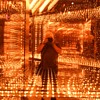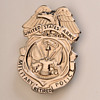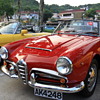Posted 11 years ago
 rniederman
rniederman
(350 items)
Here we go again. I’m posting another mysterious, extremely rare photographic accessory to ponder - can you guess what this odd, finely machined mechanical doohickey attached to the front of a lens does? I know of three. Two (including mine) are in private U.S. collections and a third in a Kodak museum in the U.K.
Take a close look at the construction. It's beautiful and in 100% original condition.
The key here is to figure out why this device was invented and sold. In other words, why would a photographer be interested in this? Guessing how the mechanics work (shouldn’t be difficult) will help.
Clue: It’s not a shutter nor is it meant to replace a shutter.
As with my previous ‘mystery accessory’ post, anyone who guesses correctly will have my admiration and that of your CW peers. And of course, this is identified. I have period advertising and an end flap of the original cardboard box.
PS: Wild comical speculation is encouraged! (You didn’t disappoint last time.)
Have fun!
************
It took less than a day for the CW crowd to figure this out. Pretty good! For those of you into 'spoilers', feel free to check out my overly detailed explanation (#46).

































Okay, at the risk of embarrassment, I will say that it regulates f stop
Jewels ... conceptually a really good start.
A "RANGEFINDER"?
For Speed ?
Oh you sneaky devil you! thought you could throw me off by picturing it upside down.
It is the little known but hugely useful attachment for personal hygiene, commonly called an "eyebrow plucker"
You position your eye next to the aperture move the little lever releasing the tension on the spring which then thightly pinches your un-needed eyebrow hairs
Take a quick step back and "Voila!" ...hairless brow.
(Sorry Karatango, I know so little French I have to use it where ever I can :)
Groucho Marx did not own one and Garrison Keillor is trying to find one.
Oops sorry again - kyratango
Okay I figured out how the device functions & you said that would help...........it doesn't. :-(
Rangefinder ... no
For speed? ... no
"Eyebrow plucker" ... hey, not a bad idea!
There is no name on the device. The only word is 'patent.'
It is attached to a camera lens. The lens is attached to the camera.
"Eye examination" ... hmmm ... I tried it and got my eyebrows plucked.
David ... think about what Jewels said.
An automatic aperture setter for the early sport/news/action photographer
A spinning rotary vignetter?
Once you've got the mechanics figured out, it's quite clear that this device is for cutting asparagus tips. The smaller the aperture, the higher your income!
Bootson ... good idea in looking at photographer's professions; but not those professions. This is not an automatic aperture setter.
John ... asparagus tip cutter for fun and profit ... that's funny. I was thinking someone would mention it being a cigar cutter.
Eye's comment (#15). You actually see the lens name engraved on the brass mounting ring and the camera's manufacturer on the lens board. But neither of these matter for the mystery because the device can be mounted on most any lens front.
Eye is really close in describing the mechanical action. (#17). Very close.
Antiplanet group lens; not sure but seems to be used mostly in portrait photography
Eric (#13) ... You nearly have it. A spinning wheel correctly describes the mechanical action. But, to nit pick, a vignette effect is not quite right.
for cropping the picture size...? or putting some kind of boarder around the picture ...hmm
A GLOBE LENS?
Does it have a winder on the other side rniederman ?? I think I have an idea !!
Tallcakes ... good call. In the end it was a poorly performing lens. I mounted the device on this camera: http://www.collectorsweekly.com/stories/117040-st-louis-reversible-back-camera-c-1887
Windwalker ... that's good guess and what Eric meant by creating a vignette. But not quite correct.
Sean ... not a lens. But there is a highly exotic lens called a globe. It's highly collectable!
musikchoo ... yes. It has a winder.
would it allow you to put more then one picture on the same plate...?
AHHA !!!!!!!!!!!!!!!!!!!!!!!!!!!!!!!!!
Lockdown feature ?
Okay so each hole lets in different amounts of light as they pass before the lens, does it give you an image with diminishing borders/
Like this image of my great grandfather?
http://cf.collectorsweekly.com/stories/dHr6TZ6Nta1u9JXzggI8yg.jpg
I should re phase that, each hole lets in different amounts of the image as they pass before the lens.
Pardon me eye4, what did you say? :-)
Was it something about an eye exam??
I'll give you 5 bucks if you e mail me the answer so I can post it ....lol
this is fun...
#19 is the answer; tho' I must admit that I simply read the important part of this from the image. It would be nice for OP to provide a description of how the lens works for portraits (in understandable 8th grade terms).
Eye4 you can have the tiara, it's all yours, but we want pictures!
Windwalker (#21 and #21). 'no' to cropping and 'no' to more then one image on a plate (that was a good question).
Musikchoo (#28) ... not sure what you mean by a 'lock down' feature.
David (#31 & #32). Correct that each hole lets in a different amount of light.
Tallcakes (#37). Although the advertisement says this can be used for landscapes, IMO a portrait photographer benefit more from this device. Portrait lenses are optimized for studio distances (to the subject) of about 12' to 25' (or so). A portrait lens isn't overly corrected (optically) to eliminate distortion (i.e. curved building lines). Portrait lenses are about letting in lots of light.
Hint 1: What is special about a portrait image that would be bad for landscape photography?
Hint 2: There is something special about different sized apertures (holes) that is more important than regulating the amount of light for an exposure. (Relates to Hint 1.)
http://books.google.com/books?id=OEgEAAAAYAAJ&pg=PA508&lpg=PA508&dq=Antiplanet+group+lens;&source=bl&ots=QyC9pya9HY&sig=b7hH7443QNNcJqi4mrQdiJPcKuc&hl=en&sa=X&ei=7i0sVKvIN8WMyATM3IHgCw&ved=0CCUQ6AEwAQ#v=onepage&q=Antiplanet%20group%20lens%3B&f=false
The maximum aperture at the 55mm end of most kit lenses is around f5.6. If this isn’t wide enough, you could buy a zoom that covers the same focal length with a maximum aperture of f4 or f2.8, or a prime 50mm lens with a maximum aperture of f1.8 or wider. The wider apertures on these lenses help you take photos in low light or to use narrow depth-of-field creatively
Windwalker ... you're on the right track ... focus (pun intended) on 'depth-of-field.' Sometimes you want it ... sometimes not. A specific lens for this discussion doesn't matter.
Is it an Aperture Device For letting in different light levels for Clarity ! (:-D)
Musikchoo is about to get lots of admiration from me!
Tell me what you think about clarity when using this device to take a picture.
I'll get back to this later on today ... lots of work to be done.
YAY !!! To Blur out unwanted Background Clutter or To Obtain Depth.
different folks want different results in their portrait; some want focus and clarity, but prolly most want a 'softened' effect to very slightly blur the details.
EXACTLY !!
Hint 1: Softer focus. Hint 2: Depth of field. So, softer focus; greater (or lesser) depth of field; and possibly shorter shutter speeds?
I have a great appreciation for old mechanical devices. Learning a lot here!
Tallcakes, musikchoo and Eric have it. This is a device to soften harshness. This was especially important in portraits for less then perfect skin.
The name of the device is "Theodore Brown's Patent Automatic Retoucher." The cardboard box flap I have has "The Automatic Retoucher." The idea was to do retouching (softening of harsh areas) in the camera and not in the darkroom.
In reality, it didn't work well (if it all) and I liken this to be the photographic equivalent of 'snake oil'. The spinning action of the wheel creates a lot of vibration which shakes the camera during the exposure. Everything got soft from the shaking. I'll post more details, advertising (etc.) later on.
Great Post and FUN !! Hope there are more !!!!!!!!!!!!!!!
Great post!
Guess I'm a little late to the party & haven't studied the other guesses. I think it is for making round & oval portrait pics.
Thanks, Phil! I knew you would appreciate the look.
Sorry to disappoint rniederman. I missed it because I was real busy waiting on parts & doing nothing. I just simply missed it when posted. I was surprised & intrigued with the real use of this.
As promised, two references are posted: a 1906 advertisement and the end flap of the box. This device was also sold as 'Tylar's Cyclofocus'. It was an English product. Different sizes were made to fit various lenses. To set, you push a post (K in the advert) to the right. It stretches a large spring and locks in place. Pushing down on the lever (F) releases the lock and spring retracting pulls a long gear that turns the wheel. The wheel then spins freely for nearly a minute.
Yet what we have here is really more promise than reality - ‘snake oil’ for photography.
In theory the device is taking advantage of two lens characteristics. The first is known as 'depth-of-field.' The smaller the aperture opening, the more things are in a wider range of focus (near-far). Second, a smaller aperture only allows light to pass through the center of the lens; typically the sharpest area. Lenses (especially vintage optics) always get 'soft' toward the edges. So ... a picture shot 'wide-open' softens at the edges of the image. But stopping down (using a smaller hole) sharpens up everything.
Portraits, ideally, focused on the eyes and the bridge of the nose. In practice, the image would then get softer further from the center of focus. This was fine with early petzval formula lenses but over the years, optical formulas improved and everything got much sharper. While this is terrific for landscapes, architecture and such, people sitting for portraits didn’t like having all of their physical flaws showing. That’s one of the reasons why CDVs were very popular. Larger images (think cabinets) took advantage of very large plates and captured all the detail; no enlarging was needed. Several photographers (including Frank Pearsall - I posted one of his cameras here on CW) took people to court to get paid because some patrons didn’t like seeing their exact likeness. Painters, on the other hand, tended to idealize portraits by removing blemishes, scars, unequal eyes, etc. In the beginning, photography worked hard to mimic the pictorial beauty of paintings before coming into its own. It eventually became an art form unto itself because it copied nature as it was meant to be.
That’s why petzval formula portrait lenses are so admired - even today. They were very large and took in huge amounts of light. They focused sharp in the center and softness increased toward the edges. But photography needed to copy nature and designers worked hard to make lenses really sharp, correct for distortions, aberrations and such. The ‘petzval look’ disappeared with improved optical designs. By 1906, lenses were pretty good and there was decent sharpness edge-to-edge.
The Cyclofocus strived to bring back the beauty of softness, but didn’t really work as intended. The spinning wheel always kept light coming into the center of the lens (the sharpest area) while the size of the opening changed. It would intermittently allow light to enter the lens edge, the softest part of the optics. So every time a wider hole passed the lens, the image softened at the edges.
Reality was a lot different. The biggest problem with the device has to do with the wheel’s balance. Larger wholes meant less metal. So the wheel weighed more where the holes were smaller. When spinning, the whole thing vibrates and shakes the lens. You couldn’t stop the vibrations. And keep in mind exposures were often longer and nearly a second in duration.
What’s interesting is that the box end-flap sees this as the value of the device: “By setting up different rates of light vibration during the exposure of the negative, shadows are softened ...” (etc.). The truth is the entire image softened because of lens was being shaken ever so slightly, but enough to see in a larger portrait. In the end, nothing was sharp or in focus.
So that’s the story ... even photography had its hucksters!
nice write up................
Know what you mean eye4. I have one in the garage with the original box & now find out it's worthless! Life is full of disappointments & guess I'll just throw it away.
Thanks, Windwalker!
Eye4 and BB2 ... send me your worthless photographic stuff!
Another intriguing acquisition, rniederman, and very impressive knowledge from the posters. My photography skills and knowledge are limited to a point and shoot camera, resulting in a success rate of about 20 percent on a good day.
You are spot on with your clever description as "‘snake oil’ for photography." The February 22, 1907 volume of "The British Journal of Photography,", page 149, courtesy of Google, wrote a negative article about Theodore Brown and his business, inventions, and subsequent bankruptcy. The end of the article talks about the failure of "The Theodore Brown Automatic Retoucher."
Left column under "Commercial & Legal Intelligence"
http://books.google.com/books?id=UE4-AQAAMAAJ&lpg=PA149&ots=N_XwHhvpOn&dq=Theodore%20Browns%20Patent%20Automatic%20Retoucher.&pg=PA149#v=onepage&q&f=false
A book was written about Brown by Stephen Herbert titled "Theodore Brown's Magic Pictures: The Art and Inventions of a Multi-Media Pioneer," London:The Projection Box, 1997. If you click on the photo of the book cover on the left, you can read quite a bit about Brown's varied interests.
Courtesy of Amazon:
http://www.amazon.com/Theodore-Browns-Magic-Pictures-Multi-Media/dp/0952394146/ref=sr_1_1?s=books&ie=UTF8&qid=1412517862&sr=1-1&keywords=9780952394143
Thanks solver for the additional info.
Thanks, fortapache!
Thanks, CindB and Kydur!
Thanks, Nicefice!
Thanks, ho2cultcha!
Overdo 'thanks' to GeodeJem!
Thanks!
fleafinder
packrat-place
Thanks!
Windwalker
Thomas
iggy
Johnsmith
Vynil33rpm
lisa